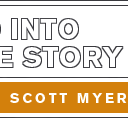The Protagonist’s Journey as Fate
“What we call fate comes not from outside us but from within.”
Ever since I began teaching as a hobby back in 2001, I have based every course on this writing mantra I coined: Begin with character. End with character. Find the story in between.
Over time, the meaning of that mantra has evolved. At first, my thinking was based on my real world experience from fifteen years working as a Hollywood screenwriter. Having written 30+ projects at every major movie studio and all but one broadcast TV network, I knew how important characters were in the success of a screenplay. If a script is in effect “actor bait,” as my DePaul colleague Brad Riddell says, it’s the characters in the context of the narrative which lure actors to want to ‘bite’ on those roles.
Over the years working with writers, both at the university level and through Screenwriting Master Class, I discovered their stories really begin to come to life when they embraced the concept their characters exist and to engage them directly. After all, it’s their story, who knows it better than the characters? The experience of working with quite literally thousands of writers deepened my understanding of my writing mantra.
Concurrently, I began to zero in on what is usually a story’s most important character: The Protagonist. Through my work over the years analyzing hundreds of movies and TV series, I realized even more why it is critical to begin the story-crafting process with this most central character. For it is their Want, their Need, their Conscious Goal, their Unconscious Goal, what they Fear the most which informs every aspect of the emerging narrative.
The last few years, my appreciation for that mantra I coined years ago has grown even more. For I have found there is a synergy between the Internal World of the Protagonist and the External World of the plot. Indeed, we can think of the events of the plot as serving and supporting the Protagonist’s transformation journey, that there is an inevitability to what transpires as it facilitates this character’s psychological evolution.
I call this dynamic Narrative Imperative. Or more simply: Fate.
What brings all this to mind is something I have done as part of my daily writing routine: Re-reading a wonderful book I highly recommend — “A Year With Rilke: Daily Readings from the Best of Rainer Maria Rilke.” I went through it a few years back, a great way to begin each day. In writing this book, my gut led me to pick it back up for inspiration.
Here is what I read this morning:
“Nothing alien happens to us, but only what has long been our own. We have already had to rethink so many concepts about motion; now we must also begin to learn that what we call fate comes not from outside us but from within… Just as for so long we were mistaken about the movement of the sun, we are still mistaken what lies ahead of us in time.”
This aligns wonderfully with the basic premise of my current writing project: The nature of the Protagonist’s journey is grounded in and propelled by that character’s psychological fate. Typically, they begin in a state of Disunity, then stage by stage by engaging challenges presented to them in the plot and intersecting with other characters who influence them, they go through a metamorphosis process leading them toward Unity.
This is not the arc of every story, but it is for most stories.
If, in fact, “fate comes not from outside us from within,” from a writer’s standpoint that steers us to begin the story-crafting process in the Internal World of our characters, most principally the Protagonist.
Begin with character. End with character. Find the story in between.
Over time, that saying has evolved in meaning, especially as I have learned the value of starting the process with the Protagonist’s journey and how it emerges as fate.
For more on Rainer Maria Rilke, go here.
